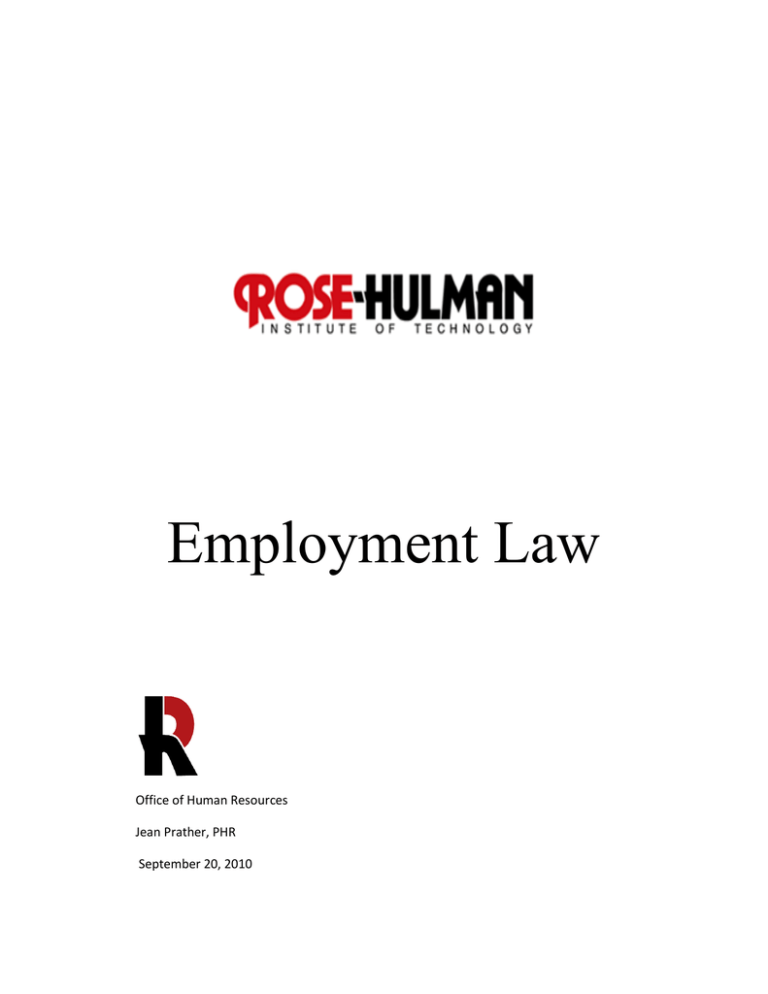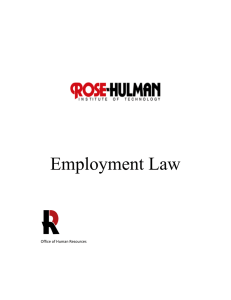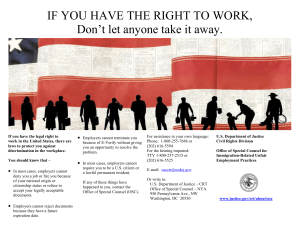Employment Law Office of Human Resources Jean Prather, PHR
advertisement

Employment Law Office of Human Resources Jean Prather, PHR September 20, 2010 Employment-at-Will Indiana is an employment-at-will state. At-will means that either the employee or the employer may terminate the employment relationship at any time and for any reason – a good reason, a bad reason or no reason at all. The importance of at-will is that it allows an employer to discharge an employee for what the employer considers sufficient reason. But, not always . . . . . Exceptions to At-Will Retaliation - an employee cannot be discharged for filing a complaint or for giving testimony for a complainant. An implied contract (arising from various employment doctrines) • Custom and practice in an organization; for example, if employees come to have “reasonable” expectations of receiving a benefit, like a Christmas bonus, a court may find the employer owes it to them. • If the organization’s handbook indicates that an employee will not be terminated, except for good cause or specifies an exact process for terminations. • For promises made to an employee: “Jim, don’t worry, your job here is permanent.” Public policy wrongful discharge claims "Public policy" is defined as that which embodies the community common sense and common conscience. It is general, well-settled public opinion relating to the duties of citizens to their fellow citizens. Some examples of public policy exceptions: • • • • An employee exercises his/her legal right (e.g., filed a workers' compensation claim as the result of an injury in the scope of employment). An employee reports a crime, when the employee has a reasonable belief that a crime has been committed. An employee cooperates with a criminal investigation. An employee is absent while serving in the military (e.g., National Guard or Reserve). 2 Age Discrimination in Employment Act - ADEA ADEA protects individuals who are 40 years of age or older. Employers who have 20 or more employees and are engaged in industry affecting commerce are covered. Indiana statute covers employees between 40 and 70 and applies to employers who have one or more employees and is not covered by ADEA. Exceptions to ADEA Age is a bona fide occupational qualification (BFOQ) – must be able to prove that those over the age requirement are unable to safely perform the job. The employer is adhering to a genuine seniority or benefit plan. The employer is disciplining or terminating an employee for good cause. The employee is a top executive or policy maker (high-level managers and certain bona fide executives or high policy makers can be required to retire at age 65 if they are entitled to receive company-sponsored retirement benefits of at least $44,000 per year and have held the position for two years prior to retirement). Potential Penalties • • • • • • Back pay Reinstatement or front pay Retroactive seniority Compensatory damages Punitive damages Attorneys’ fee Americans With Disabilities Act of 1990 – ADA (Title I & Title V) & ADAAA (2009) ADA prohibits employment discrimination against qualified individuals with disabilities in the private sector, and in state and local governments. ADA applies to private employers with 15 or more employees. Disabled means that one is substantially limited in a major life activity, i.e. caring for oneself, performing manual tasks, walking, seeing, hearing, speaking, breathing, learning, working and participating in community activities. The ADA’s definition includes individuals who have a record of, or who are perceived as having, such an impairment. Exclusions to ADA: Indiana ADA mirrors the federal ADA. The disability provisions of Indiana Civil Rights Law covers employers with between six and 14 employees. Employers are to make a reasonable accommodation for a disabled employee as long as it does not impose an undue hardship on the business operation. Determinations are made on a case-by-case basis. Held to the same production standards as all other employees. 3 Examples of reasonable accommodations: • “Flexing an employee’s work schedule to meet the needs of medical treatment for disabling conditions, i.e. chemotherapy, physical therapy. • Providing moderately priced adaptive devices, i.e. telephone amplifiers for the hearing impaired, video monitor enlargers for vision impaired (or even assigning a reader to help), modified office equipment for one who is wheelchair bound. • To learn more about reasonable accommodations: http://www.jan.wvu.edu/ Exceptions to ADA Homosexuality, bisexuality, transvestitism, and compulsive gambling are not physical or mental impairments. Also does not protect current drug users. Potential Penalties • • • • Back Pay Compensatory Damages Punitive Damages Attorneys’ fees ADAAA Rehabilitation Act of 1973 Employers with federal contracts and subcontracts exceeding $10,000 or employers that receive federal financial assistance may be required to take affirmative action to employ the disabled (special, proactive efforts to attempt to increase or promote). Consumer Credit Protection Act – CCPA Protects employees from discharge by their employers because their wages have been garnished for any one debt, and it limits the amount of an employee's earnings that may be garnished in any one week. • Does not protect an employee from discharge if the employee's earnings have been subject to garnishment for a second or subsequent debt. 4 Employee Polygraph Protection Act of 1988 (EPPA) The Employee Polygraph Protection Act (EPPA) applies to most private employers. The law does not cover federal, state, and local governments. The EPPA prohibits most private employers from using polygraph tests, either for pre-employment screening or during the course of employment. Prohibits requiring employees to submit to a polygraph test, considering the results of a polygraph test in decision making and disciplining/terminating an employee who refuses to take a polygraph test. Subject to restrictions, the Act permits polygraph tests to be administered to certain job applicants of security service firms (armored car, alarm, and guard) and of pharmaceutical manufacturers, distributors, and dispensers. Subject to restrictions, the Act also permits polygraph testing of certain employees of private firms who are reasonably suspected of involvement in a workplace incident (theft, embezzlement, etc.) that resulted in specific economic loss or injury to the employer. Equal Pay Act of 1963 – EPA The Equal Pay Act protects men and women who perform substantially equal work in the same establishment from sex-based wage discrimination. Applies to employers with 2 or more employees. Employees can be paid differently • Seniority/merit based pay • Quantity/quality based pay • Other factors not based on gender, including differences in the amount paid by shift and employee qualifications. Potential Penalties • • • • • • • Back pay Reinstatement or promotion Front pay Monetary penalties Injunctive relief Imprisonment Attorneys’ fees 5 Fair Credit Reporting Act – FCRA FCRA promotes the accuracy, fairness, and privacy of information in the files of consumer reporting agencies. It applies to employers who order consumer reports from a consumer reporting agency (third party background checks). A consumer report is information relating to an individual’s credit, general reputation, criminal history or personal characteristics. Applicant must be notified, in writing, of intent to obtain report and we must get their written permission before requesting one. A Consumer Reporting Agency may report negative information for seven years with certain exceptions: • • • • • Information about criminal convictions may be reported without any time limitation. Bankruptcy information may be reported for 10 years. Information reported in response to an application for a job with a salary of more than $75,000 has no time limit. Information reported because of an application for more than $150,000 worth of credit or life insurance has no time limit. Information about a lawsuit or an unpaid judgment against you can be reported for seven years or until the statute of limitations runs out, whichever is longer. If there is a negative report • • • A copy of the report is provided to the applicant The name, address and phone number of the reporting agency providing the report is provided to the applicant A summary of the applicant’s FCRA Rights is provided to the applicant Fair Labor Standards Act – FLSA FLSA establishes: • • • • minimum wage overtime pay for non-exempt employees record keeping standards for employees under its provisions child labor laws Applies to employers with 2 or more employees. FLSA requires employers of covered employees who are not otherwise exempt, to pay a minimum wage of not less than $6.55 an hour as of July 24, 2008. Indiana has the same minimum wage requirement. Going up to $7.25 effective 7/24/09. 6 FLSA (and Indiana Law) require that overtime be paid to non-exempt employees at a rate of one and one-half times the employee’s regular rate of pay for each hour worked in each workweek in excess of 40 hours. RHIT pays overtime for over 40 hours, even if not worked; i.e. sick, vacation. The most common FLSA minimum wage and overtime exception is often called the “541” or “white collar” exemption which applies to certain: • Executives • Administrative employees • Learned Professional employees • Creative Professional employees • Computer employees Child labor laws require employees under the age of 16 to be provided a 30 minute break after five hours. There are no other legal requirements for breaks or lunch periods (under Indiana or Federal law). Information on Indiana child labor laws is attached. Potential Penalties • • • • • • • Back pay Overtime pay Monetary fines Punitive damages Injunctive relief Criminal penalties Attorneys’ fee Family and Medical Leave Act – FMLA FMLA provides an entitlement of up to 12 weeks of job-protected, unpaid leave during any 12-month period for the following reasons: • Birth and care of the employee's child, or placement for adoption or foster care of a child with the employee. • Care of an immediate family member (spouse, child, parent) who has a serious health condition. • Care of the employee's own serious health condition. Applies to employers with 50 or more employees within a 75 mile radius. To be eligible, employee must have worked for the organization one year and worked at least1250 hours during the previous 12 months. FMLA may be taken in blocks – off for three weeks in a row, or intermittently – off for a few hours at a time. 7 Can run concurrently with paid vacation and sick time and worker’s compensation. National Defense Authorization Act (January 2008) Permits a "spouse, son, daughter, parent, or next of kin" to take up to 26 workweeks of leave to care for a "member of the Armed Forces, including a member of the National Guard or Reserves, who is undergoing medical treatment, recuperation, or therapy, is otherwise in outpatient status, or is otherwise on the temporary disability retired list, for a serious injury or illness.” Also permits an employee to take FMLA leave for “any qualifying exigency” arising out of the fact that the spouse, or a son, daughter, or parent of the employee is on active duty (or has been notified of an impending call or order to active duty) in the Armed Forces in support of a contingency operation” (awaiting Secretary of Labor’s final regulations defining "any qualifying exigency”). Qualifying exigency might be closing up a home, mowing grass, banking, etc. Responsibility to inform employee of Rose-Hulman FMLA Policy Forms to be completed Potential Penalties • • • • Back pay Reinstatement Benefits Attorneys’ fees Immigration Reform and Control Act of 1986 – IRCA Requires completion of the I9 (Employment Eligibility Verification Form) to verify that every employee hired after 11/06/1986 is authorized to be employed in the United States. Also contains an anti-discrimination section barring “unfair immigration-related employment practices.” Employers must keep each I-9 on file for at least three years, or one year after employment ends, whichever is longer. Additionally, this Act allows employment of alien workers in certain specialty occupations (generally those requiring a bachelor's degree or its equivalent), who may be employed under the H-1B visa classification. Pregnancy Discrimination Act of 1978 – PDA PDA protects pregnant women, women who have given birth, or have other “related” conditions from employment discrimination and requires employers to be non-discriminatory in providing employee benefits such as: Health insurance, sick 8 leave, pensions, and vacation time. Applies to employers with 15 or more employees. Some federal courts have recently defined “related conditions” to include abortion and in vitro fertilization procedures. Pregnancy related benefits can’t be limited to married employees. The decision of when to start pregnancy leave is up to the employee and their physician – as long as they are able to perform their job. Title VII of the Civil Rights Act of 1964 Title VII prohibits discrimination based on race, color, religion, sex, or national origin. Applies to private employers with 15 or more employees Indiana Civil Rights Law prohibits discrimination on the basis of race, religion, color, sex, disability, national origin or ancestry. Civil Rights Act of 1990 In cases of intentional employment discrimination, allows for monetary damages. Uniformed Services Employment and Re-Employment Rights Act –1994 - USERRA Applies to all employers. The pre-service employer must reemploy service members returning from a period of service in the uniformed services if those service members meet five criteria. • • • • • Employee must have left employment Employee must have given notice (oral or written) unless military necessity prevents giving notice Length of Absence is not to exceed five years (there are exceptions for certain military specialties) Reporting back to work based on length of service Disqualifying service – dishonorable or bad conduct discharge. Potential Penalties • • • • Reinstatement Back pay Liquidated damages Attorneys’ fees Worker Adjustment And Retraining Notification Act -Warn Requires some employers to give a minimum of 60 days’ notice if a plant is to close or if mass layoffs will occur. This act allows displaced workers adequate time to 9 • • • search for a New job. Affects employers who employ 100 full time employees A mass layoff is a reduction in force, during any 30 day period that results in the employment loss at a single site for either 50 or more full time employees, if they compose 33% of the workforce at the employment site, or 500 or more full time employees. The 60 days’ notice must be given to: • The affected workers or their representatives • State dislocated worker units • The chief elected official of the local government where the closing or layoff will occur. 10



